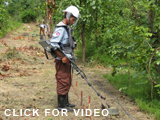





 |

Prior to the early 1990s, Mozambique endured 30 years of conflict, leaving the country littered with landmines and explosive remnants of war (ERW). Mozambique’s landmine and explosive remnants of war (ERW) problem was one of the most severe in the world.
On 17 September 2015, Mozambique announced it had completed clearance of antipersonnel mines on its territory. In a public ceremony, Foreign Affairs and Cooperation Minister Oldemiro Baloi declared the country to be free of the “threat” of mines following survey and clearance of more than 3,000 areas across a total of over 55km2 in 2008–2014, with the destruction of more than 86,000 antipersonnel mines. Mozambique was once one of the most heavily mined countries in the world, and major demining operations, which began in 1993, concluded in 2015 after 22 years.
The clearance of antipersonnel mines in Mozambique has had significant socio-economic benefits for the country, enabling development investment in support of natural resource mining, agriculture, and infrastructure construction, while also directly contributing to Mozambique’s national Poverty Reduction Action Plan. Other benefits from clearance include increased mobility and opportunities for cross-border trade for local populations along the Mozambique-Zimbabwe border and longer-term benefits for rural communities through improved access to health and education services and facilitating their expansion.
The US Humanitarian Demining Research and Development (HD R&D) Program made an important contribution to this success story. The HALO Trust, one of the international demining non-governmental organizations working in Mozambique, integrated two HD R&D Program technologies into their clearance operations; the Handheld Standoff Mine Detection System (HSTAMIDS) and the Orbit Screener. HALO completed clearing their assigned suspected hazardous areas by the end of 2014, reporting that they would not have met their schedule without the use of these two systems. The mechanical Orbit Screener and the Handheld Standoff Mine Detection System (HSTAMDS) cleared 5,073 mines from 770,709 square meters of land between January 2011 and the end of 2014.
Sources: To Walk the Earth in Safety, 2023
Landmine Monitor Report, 2020
|
|
ORBIT SCREENER |

|
The Orbital Action Screening Plant Model 68 efficiently sifts through a variety of soil types for landmines of all sizes. Material is loaded into the 1.8 cubic-yard hopper and fed into a rotating and tilted screen of appropriate size that quickly separates large and/or light items from soil. The highly portable and user friendly Orbit Screen is highly resistant to plugging with plastic, paper, sticks, and vegetation.
Distribution Statement A: Approved for public release.



PARTNERS: Ecuador (2010); The HALO Trust - Afghanistan, The HALO Trust - Mozambique (2011-2014); Mines Advisory Group - Iraq
|
|
HSTAMIDS |

|
The Handheld Standoff Mine Detection System (HSTAMIDS) is the U.S. Army`s AN/PSS-14 dual sensor, handheld mine detector that combines an electromagnetic induction sensor and ground penetrating radar (GPR) to detect landmines. The addition of the GPR significantly reduces the detector`s false alarm rate and the time the operator spends investigating clutter, increasing the operator`s speed and effectiveness. The HD R&D program also developed the HSTAMIDS F3S variant which incorporates a more sensitive metal detector to improve performance against deeply buried low metal anti-personnel and anti-tank mines.
Distribution Statement A: Approved for public release.



PARTNERS: The Halo Trust in Afghanistan, Cambodia, Mozambique (2012-2014), Kosovo,Sri Lanka and Zimbabwe; Mines Advisory Group in Angloa and Cambodia; Cambodia Mine Action Centre (2009-2010); Norwegian Peoples Aid in Zimbabwe (2014-2016)
|
|
    
|
|

